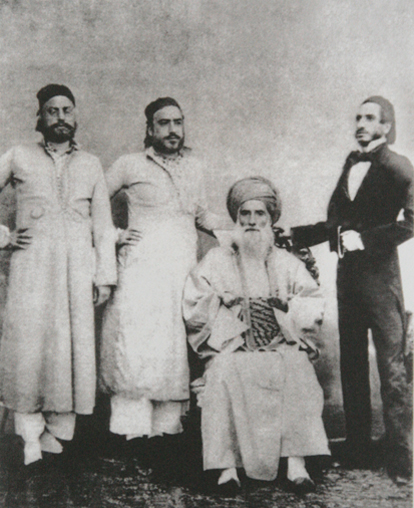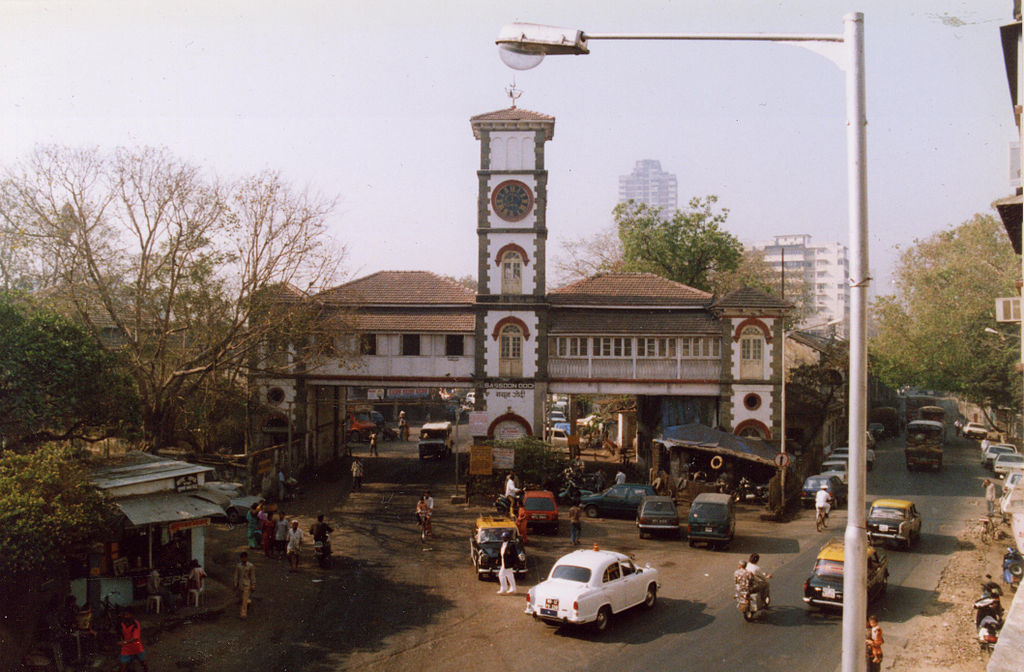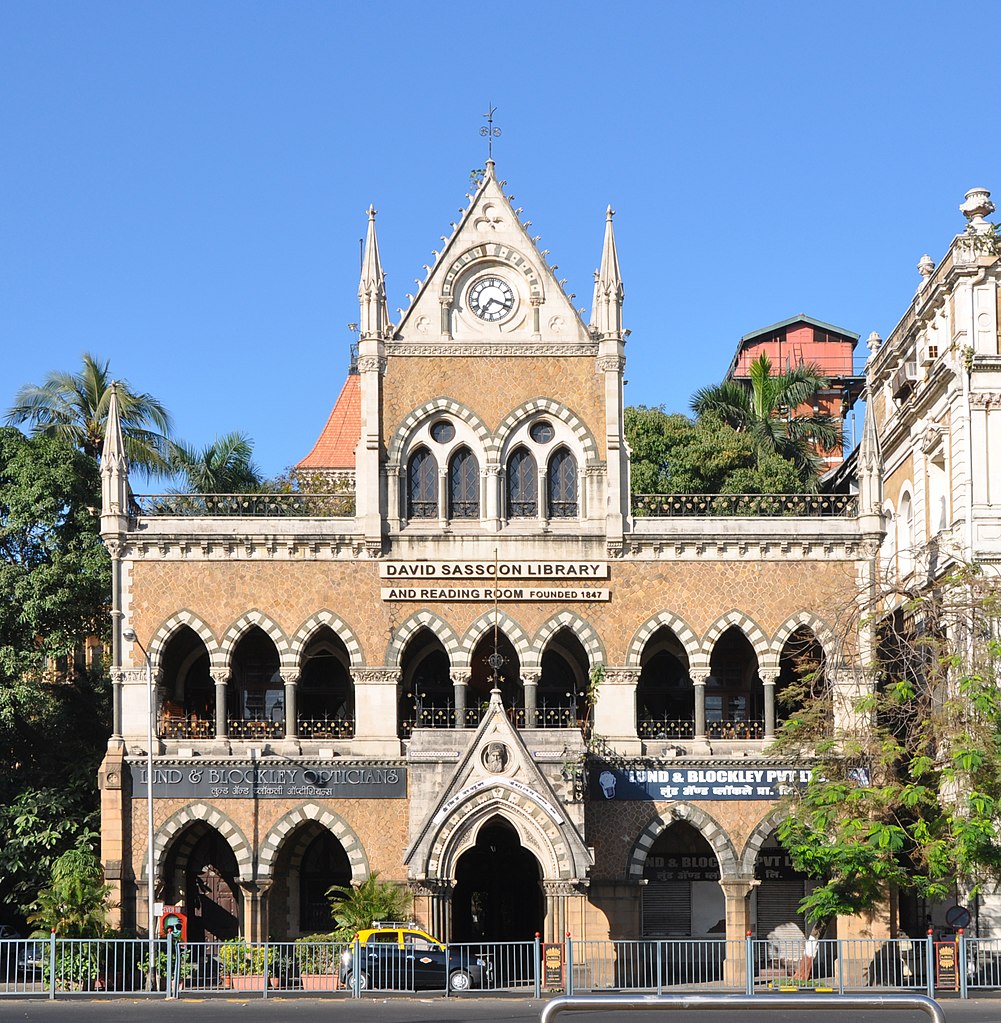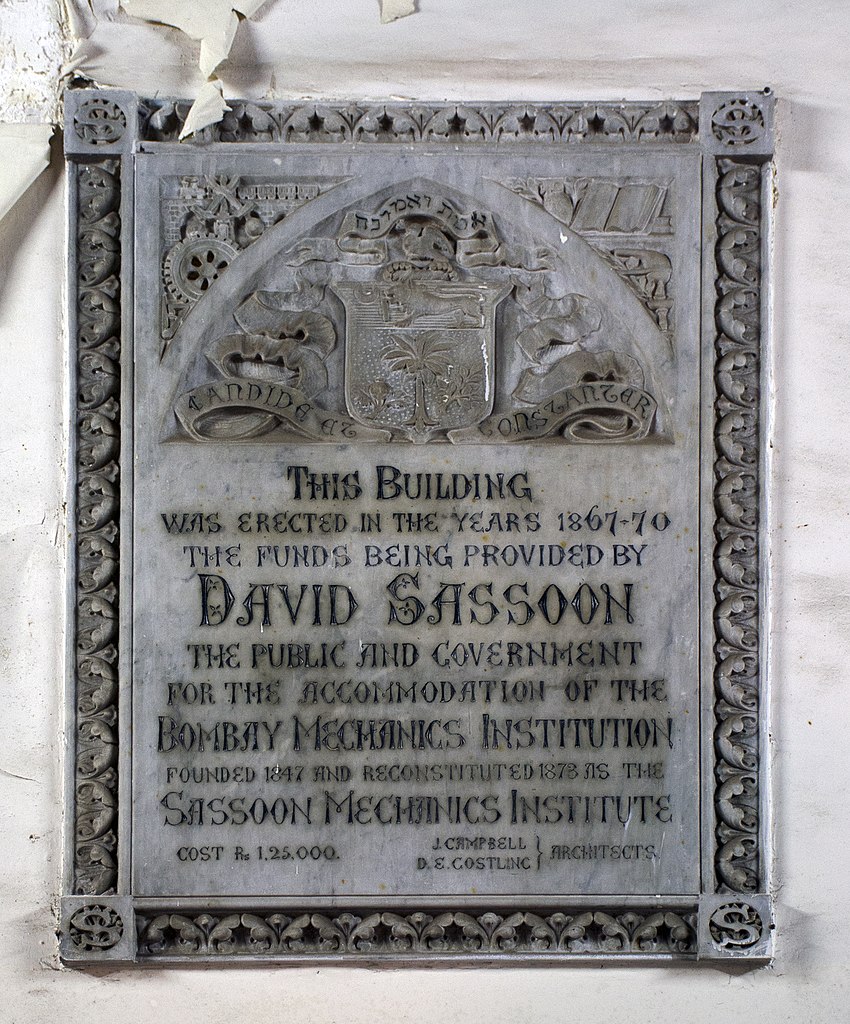Scratch the surface of modern Mumbai and you will quickly find a link to the Sassoons. Jewish refugees from Baghdad who arrived in colonial Bombay in 1830, the Sassoon family endowed their new home with institutions, schools, infrastructure, and places of worship, many of which continue to function today. Kala Ghoda, the gentrifying southern tip of the Fort district, owes its name to the statue of the future King Edward VII gifted by the family in 1879. The Sassoons owned vast swathes of property in what is now the city's centre, upon which they built many of the mills which powered Bombay’s economy into the mid-20th century. This property is now ground zero of India’s Billionaire-Raj-landscape of cloud-piercing towers, malls, and business complexes.
It is this property which perhaps best symbolises the rise and fall of the Sassoon family. They bought it up in the late 19th century, while assembling a stunningly global business empire which earned them the sobriquet of the “Rothschilds of the East.” Then they sold it off in a huff in the 1930s and 1940s, thereafter retreating to the Bahamas. It was left to other Indian firms to capitalise on this land, but by that point in time the Sassoon firm was already a distant memory.
How did a family of refugees build up a multinational firm from 19th century colonial Bombay?
Joseph Sassoon’s The Global Merchants documents the family’s rise and fall in dramatic detail. This is a book which significantly adds to our understanding of global capitalism and business history, on the one hand, and diasporas and minority identity, on the other hand. Bombay and the Bahamas are mere bookends in a world-spanning story where the Sassoons’ mercantile reach encompassed China, Japan, the Ottoman Empire, and imperial London. How did a family of refugees build up a multinational firm from 19th century colonial Bombay? And how did they lose it all – not just their fortunes and landholdings, but also, as we will see, their very religious and cultural distinctiveness?
In Joseph Sassoon (distantly related to his subject matter), the family has a uniquely qualified chronicler: he can read the Baghdadi Jewish dialect in which the Sassoons’ commercial correspondence was written until the early 20th century. Somehow, this correspondence – scattered between family branches in India, China, and Britain – was meticulously preserved and deposited in Israel’s National Library.

Working with this material, the author begins in Ottoman Baghdad, when, in the 1810s and 1820s, political machinations prompted the dispersal of the city’s powerful and wealthy Jewish community. As Baghdad’s cosmopolitanism frayed, a British political agent in the city might have played an outsized role in the Sassoons’ history: he probably helped Sheikh Sassoon, the family’s head, start thinking about refuge in British India, particularly in the emerging commercial entrepot of Bombay. Sheikh Sassoon died in Bushire, but his son, David, completed the journey onwards to India and immediately set about scouting for business opportunities.
He did not have to search for long.
It is through the immigrant David that we receive an extraordinary picture of Bombay’s cosmopolitanism in the 19th century. Fluent in Arabic, Hebrew, Turkish, and Persian, David quickly picked up Hindustani while making contacts in the city’s cotton exchange. He rubbed shoulders with Parsi magnates, French-Syrian Jewish business partners, Iranian merchants, and British officials. One of his closest friends was the Scottish missionary John Wilson, with whom he studied and debated the Old Testament in a mixture of Arabic and Hindustani. English proved difficult for him to master – he invariably responded in his native tongue – but David courted the high and mighty of the Raj, hosting them at a palatial residence in Byculla which he named Sans Souci (French for “no worries”).
Bombay’s diversity, along with a commercial spirit which gave little heed to one’s religion or place of origin, provided fertile ground for a multinational firm.
In Bombay, the Sassoons forged a uniquely hybrid identity, joining the Indian civic and mercantile elite but also coveting British citizenship. And they preserved certain rhythms of Jewish life from Baghdad, such as its cuisine. Like other Baghdadi Jews in the city, they were intensely religious: Bombay’s tramways even issued special Sabbath passes so Jewish passengers could avoid handing money to ticket collectors on Saturdays.
All of this illuminates colonial Bombay’s unique role as a laboratory for globalisation in the mid 19th century, a crossroads for much more than just the Indian Ocean world. Unlike many other histories of global capitalism, The Global Merchants puts non-Europeans and a colonial city in the very front and centre of the story. Bombay’s diversity, along with a commercial spirit which gave little heed to one’s religion or place of origin, provided fertile ground for a multinational firm. Where else could a turbaned, Arabic-speaking Jewish man from Iraq, living in an English-style mansion with a French name, become a respected city father and a household name amongst locals?
David began building his empire by looking to the west and trading with merchants in the old country. But it was by looking to the east, and specifically the opium trade with China, that he made his fortunes. The Sassoons keenly sought out business opportunities on the back of British imperial conquests. After the First Opium War (1839–42), David began dispatching his sons to various Chinese ports. Soon enough, the Sassoons established a firm hold on the movement of prized Malwa opium through Bombay and onwards to the Chinese market.

Most accounts of Bombay’s involvement in the opium trade end in the 1850s, when Indian merchants began deploying their capital towards new textile mills. For the Sassoons, as The Global Merchants makes clear, the 1850s were just the starting point. For the rest of the century, the Sassoons rode high on burgeoning opium profits. Joseph Sassoon demonstrates that the Indian opium trade to East Asia was alive and kicking as late as the 1920s, several years after the British and Chinese governments agreed to halt it. The Sassoons embraced new technology, such as the telegraph, which enabled them to be “among the pioneers in developing investments and trades that were globally oriented rather than local.” They vertically integrated, buying up steamships which transported opium, venturing into maritime insurance to protect investments in those ships, and sitting on the boards of banks which financed the whole juggernaut.
The Sassoons embraced new technology […] which enabled them to be “among the pioneers in developing investments and trades that were globally oriented rather than local.”
Although the family later diversified into cotton textile manufacturing, it was through opium that the Sassoons became a global firm. They depended on politics in Britain; supply of the drug from the Ottoman Empire, Iran, and India; and demand in China and Southeast Asia. While a storm of moral revulsion towards the opium trade gathered force in Europe and India, the Sassoons took evident pride in their business. David’s son, Abdallah, commissioned a family crest which featured a bulging poppy.
Joseph Sassoon states that he found no evidence in the archives of any family misgivings about the opium trade. This is not too surprising: as with cigarettes, fossil fuels, or other such commodities, opium was too profitable for its peddlers to think twice about it. And there were always claims that opium was harmless and actually enhanced one’s mental abilities – claims which the Sassoon firm embraced, regardless of their veracity. What is more noteworthy is that later generations entirely forgot about the family’s original connections with the drug. Abdallah’s generation vigorously lobbied against anti-opium activists but, once the drug ceased to be profitable, their children took recourse to historical amnesia.
<<>>
Abdallah and his brothers (David had eight sons; the Parsi merchant Jamsetjee Jejeebhoy once quipped that David’s key asset was his progeny) milked as much as they could out of Indian opium pods, but they took other family matters in a very different direction. They loosened their bonds with India: Abdallah, for example, relocated to London, anglicising his name to Albert. In Victorian Britain, Albert and his brothers used their opium fortunes to purchase stately houses and curry favour with the royal family. Reuben Sassoon became a favourite companion of the Prince of Wales, the future Edward VII, even functioning as the prince’s “unofficial bookie” at the races.
But the brothers did partake in one very Indian tradition: they fought amongst themselves, splitting the firm in two shortly after their father’s death. From the 1860s onward, David Sassoon & Co., the original firm, and the newly launched E. D. Sassoon & Co. became bitter rivals in the opium trade. While lacking Ambaniesque public drama, the family rift served as the first crack in the mighty Sassoon edifice.
Family dynamics also led to one extraordinary episode. With Albert enjoying society life in London, the reins of David Sassoon & Co. in Bombay fell to his brother Suleiman. After Suleiman passed away in 1894, his widow, Farha, took control. Farha, Joseph Sassoon tells us, was likely the first woman to preside over a global business. That she did so from colonial India is even more noteworthy: when British officials and Indian merchants did business with the Sassoons, they now had to shake hands with a female executive, no doubt a bruising experience for their male egos. Farha professionaled the family firm, replacing its freewheeling chaos with some semblance of order, and expanded business operations beyond opium.
The Sassoons’ focus shifted from business to identity and status. Opium profits dwindled, but few were bothered; they already had enough sterling in the bank.
This was too much for many of the Sassoon men. Flabbergasted by her business acumen, they conspired to remove her from the firm’s leadership. Unfortunately, they succeeded, and another fatal crack was driven through the Sassoon empire. Farha took this backstabbing with grace and composure, eventually deciding to relocate to London, where she became Flora. Indian society deeply mourned her loss: before she departed, one Parsi admirer anointed her as “Her Majesty, the Queen of Bombay and Empress of Malabar Hill.”
By the third generation, the Sassoons’ focus shifted from business to identity and status. Opium profits dwindled, but few were bothered; they already had enough sterling in the bank to finance their extravagant lifestyles. As more family members gravitated to London, they shed their Baghdadi Jewish identity. “The changes that took place over a relatively short period were staggering,” remarks Joseph Sassoon. First, they integrated into the European Jewish elite, marrying into wealthy Ashkenazi families. Albert’s son, Edward, wed a Rothschild daughter. For their marital reception, they hired out nothing less than the choir of the Paris Opera.

Then, by the fourth generation, the Sassoons shed much of their Jewishness. Albert’s grandchildren, Philip and Sybil, turned their backs on their heritage as well as their business, potential blots on their English aristocratic airs. Art connoisseur Philip, for example, became the head of David Sassoon & Co. but rarely sullied his hands with its commercial matters. As Britain’s undersecretary for aviation, he toured Baghdad and Bombay but made no effort to reach out to family members or, for that matter, his employees.
Fourth generation Sassoons seemed downright embarrassed by reminders that they were not, after all, blue-blooded Englishmen and Englishwomen. They winced when relatives from “the Orient” visited them. They might have contemplated removing the Hebrew lettering (but evidently not the opium pod) from the family crest which Abdallah/Albert commissioned. The wartime poet Siegfried Sassoon, who embraced Roman Catholicism in his later years, went further: he expressed overt hostility towards his family. “They made it in the East by dirty trading, millions and millions of coins,” he believed. “They spent it all in draper’s shops and jewellers and pastry cooks and brothels.”
<<>>
Joseph Sassoon believes that this alienation and anglicisation were the final nails in the coffin of the Sassoon empire. “The price of assimilation wasn’t only the loss of ties to an old faith or an old home, but also to the global business which had brought them to England in the first place,” he remarks.
It is a controversial argument, but ultimately a convincing one (and to me, it sounds painfully similar to what is happening to the disintegrating Parsi community). The Sassoons built their global business through Baghdadi Jewish networks, recruiting community members, whom they knew and trusted, and dispatching them to faraway posts. Business communication in the Baghdadi Jewish dialect was indecipherable to outsiders. The family funnelled a good chunk of their philanthropy into their community, helping distressed families in the old country and building up Jewish infrastructure in India and China. Once this distinctiveness and shared culture disappeared, the firm lost much of its energy and raison d’être. David Sassoon & Co. withdrew from India, management passed out of family hands in London, and the firm limped along until it was unceremoniously liquidated sometime in the 1980s.
The Sassoons built their global business through Baghdadi Jewish networks […] Once this distinctiveness and shared culture disappeared, the firm lost much of its energy and raison d’être.
E. D. Sassoon & Co. provided a more dramatic denouement to the family’s fortunes. The company remained in Bombay, where it reluctantly weaned itself off the opium trade and channelled its energies into those big textile mills whose ruins still peek out between the skyscrapers of central Mumbai. Victor Sassoon, who took the helm of E. D. Sassoon in the 1920s, upgraded and expanded these mills. But Victor soon soured on India’s political direction, seeing communist conspiracies everywhere and forecasting doom if the Indian National Congress came to power.
And so, in 1931, he made the fateful decision to relocate to China’s commercial capital, Shanghai. In Shanghai today, one has to scratch the surface a little harder to find a Sassoon connection, but it is there nevertheless. Many of the Art Deco landmarks in the erstwhile International Settlement were built by Victor, who went on a property-buying spree in the 1930s and hired New York architects to build China’s first skyscrapers. Occupying the top floor of his Cathay Hotel on the Bund, Victor adopted a playboy lifestyle. He sought the company of beautiful women and, rather creepily, offered to photograph them. In Victor’s personal archives there are “thousands of such photographs, many of them portraits of women he met by chance, and a few in swimming suits, sparsely clad, or totally naked.”

In public, Victor cultivated the demeanour of a serious commentator on global affairs. Yet he had spectacularly bad judgment. Having launched a small-scale red scare in India, Victor believed China to be immune from communist designs. When the Japanese invaded Shanghai in 1937, he attempted to mediate between them and western powers, telling American audiences that Japan would never enter the widening global war. When Japan did precisely that, Victor found himself shut out from Shanghai and had to slink back to Bombay.
What if the Sassoons had not abandoned India? […] Perhaps they could have followed the path of the Tatas and made their peace with Nehruvian socialism.
The war accelerated his spate of bad decision-making. Victor’s prognosis of India’s future became grimmer and, consequently, E. D. Sassoon began selling off its mills and other Indian assets in a tearing hurry, often at depressed prices. Victor did not have to liquidate his business in Shanghai. Chinese communists did that for him after 1949, nationalising properties worth over a billion dollars today. Friends urged Victor to invest his shrivelled fortune in Hong Kong but he rubbished that suggestion in favour of life in another island territory, the Bahamas. Victor’s time in the Bahamas was marked by two seminal events. In 1959, he married his Texan nurse, a woman four decades younger than him. In 1961, he died.
<<>>
Thus ended the Sassoon family business. This inglorious end practically begs the question—what if? What if the Sassoons had not abandoned India? Had they followed David’s example and not remained aloof from Indian society, perhaps they could have followed the path of the Tatas and made their peace with Nehruvian socialism. What if Victor had followed his friends’ advice and invested in Hong Kong? The Kadoories, fellow Baghdadi Jews with Shanghai investments, did precisely that and remain in business today.
Ultimately, The Global Merchants is a story of confused identities and lost opportunities. The Sassoons had misgivings about becoming Indians and they were never British enough to be fully accepted by London aristocrats. Early generations were fervently Jewish, yet their Ashkenazi in-laws questioned their indifference to causes like Zionism. For the last generation, perhaps places like the Bahamas were enticing precisely because they were so physically removed from the family’s heritage and history. Had they set down firmer roots in India, perhaps the Sassoons would now still be riding high – upon real estate bubbles rather than Malwa opium. Instead, they are lying in neglected tombs in the shadow of those Mumbai towers they could have built.
Dinyar Patel is an assistant professor of history at the SP Jain Institute of Management and Research, Mumbai. His first book, 'Naoroji: Pioneer of Indian Nationalism', won the Kamaladevi Chattopadhyay NIF Book Prize 2021.









